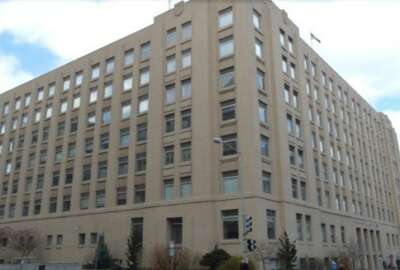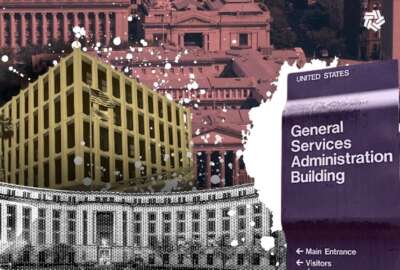

The General Services Administration buys many things. Since 1972, it has commissioned some 500 works of art to hang in — or otherwise adorn — federal buildings.
Best listening experience is on Chrome, Firefox or Safari. Subscribe to Federal Drive’s daily audio interviews on Apple Podcasts or PodcastOne.
The General Services Administration buys many things. Since 1972, it has commissioned some 500 works of art to hang in — or otherwise adorn — federal buildings. To find out the latest in the 50-year-old Art in Architecture program, the Federal Drive with Tom Temin talked with the director of GSA’s Center for Fine Arts, Jennifer Gibson.
Interview transcript:
Tom Temin: At cocktail parties, when you say fine arts and General Services Administration in the same breath, do you get a lot of eyebrows?
Jennifer Gibson: Absolutely. And generally, what I go on to explain, it’s a little like being a director of a museum that’s all over the country, with one work in every city, and the federal government has this amazing collection. And we continue to add to it, and that always causes people to pause, they’re amazed that their government does this and then tend to get very excited about it.
Tom Temin: And this program dates back to an executive order from the Nixon administration, which built on I think, the general architecture program that was established in the Kennedy administration. So there’s a long, proud history here. But tell us about how the program works.
Jennifer Gibson: Basically, anytime the federal government, GSA is building a new building, or doing a major modernization of a building that we already have, we have by regulation, one half of 1% of the estimated construction cost to commission a site-specific artwork. So over the course, as you just mentioned, over the course of the past 50 years, we’ve commissioned over 500 works. And we’re continuing on with the many new projects that are coming up.
Tom Temin: When you mentioned site-specific, that means it could be a hanging painting, but more often than not, it’s maybe what sculpture or murals?
Jennifer Gibson: It can be a painting. Basically, what we’re doing is commissioning civic art. This is art intended to be seen by the public, and be in publicly accessible parts of the building. So it’s outside, it’s on a plaza. It’s in a lobby, it’s someplace where people, the general public can see it. And the work is, tends to be large scale. So we’re not looking at small easel size paintings, or portable sculpture. We’re doing large scale permanently installed works. So yes, we have paintings, but the paintings may be 90 feet long and 10 feet tall.
Tom Temin: Interesting. And tell us the process for first of all commissioning, which artist is there a competition and how the decisions get made on what you’ll end up with? Because I imagine that’s fraught with a lot of opinions.
Jennifer Gibson: Yes, art tends to elicit strong opinions. It is the art and architecture program is a federal procurement process. So we have to obey all of the federal regulations on acquiring services and products. And for each commission, we set up a specific panel, we don’t have a single body of people who are making the selections. That panel includes seven members, it’s the primary federal tenants. So if we’re working on a courthouse, one of the federal judges sits on the panel for working on a border station, somebody from Customs and Border Protection is a participant, we also have the lead designer. So this is the person who knows how the building is going to work, the materials, the spaces and can provide guidance, and who often has worked with artists in the past, we involve the community both with through the federal tenant, and then with a community representative. This is somebody who really knows a community and can provide insights into what’s important to that community. We have an arts professional also from the area. So this is a person we’re hoping is really tuned in to what artists are around and can perhaps participate in this project. And then we have a national arts representative in GSA. This panel will meet several times; once to just learn about the project to learn about what the agency that’s going to be occupying it does. Most people don’t know how a federal courthouse works, or what’s really going on at a border station. And those kinds of things get discussed. The agency representative also explains what’s important to that agency. The community member talks about the community so you learn a lot about the site that panel’s then responsible for thinking about ways art might be incorporated into the project, and they can recommend artists to be reviewed. We will do a solicitation just as all government solicitation so an artists who might be interested in being considered can submit materials. And we have something called the national artists registry, which is available online or any artist who’s a U.S. citizen or a lawful permanent resident can participate in the national artists registry. Once they submit their materials, which is basically images of past work and a resume, they can be considered for any project anywhere in the country, all of those potential candidates are reviewed by criteria that the panel has set. And they meet again to look and sort of, they rate potential artists, then we do procurement. We go through all everything that’s been stated by the panel, what’s important to them, we then go through all these various evaluation factors to make a recommendation, the artists who is selected is under contract, and then they start to work on the design that’s shared with the panel, we seek their comments and approval before proceeding.
Tom Temin: We’re speaking with Jennifer Gibson, she’s director for the Center for Fine Arts at the GSA. So in many ways commissioning the art is similar to commissioning the building, you need functionality, but you also need design and tastefulness. And something that the community can accept.
Jennifer Gibson: Absolutely, it’s important, we want the community to embrace the art both the community outside the building and the tenants of the building. So it’s, it’s not a process where we’re, it’s anybody’s coming and saying, this is the art that’s good for you, or this is what we need. It’s really a collaborative process. And the artist becomes part of the design team. They’re totally integrated, both as far as their schedule, and how they are, their work is incorporated into the building, because as I mentioned earlier, these are permanently installed buildings. And they tend to be complex installations that require the support also of the building design.
Tom Temin: And just a quick question on the regionality you mentioned that the national, the artists registry is national, but how much does the region come into play? Say, for example, would you show a and I’m just making this up a snowy pine forest in New Mexico and a sunny orange Adobe scene in Maine?
Jennifer Gibson: Generally not, but it could happen. That would be part of the discussion, there actually is a work in Alaska of diving pelicans that everybody is convinced was actually intended for Florida. And it wasn’t, it was Alaska artists who designed that work and pops up in the press every once in awhile in the last year. But it’s in that back and forth, the work that’s created tends to be appropriate for the function of the building and for the location, the geographic and regional character of the site.
Tom Temin: You know, increasingly, art is becoming politicized. And there’s political content. And sometimes people derive political content from old art, because the sensibilities now are different from 50, 75 years ago, and so on, does that ever come up in the change things out, some group of people decide, you know, this doesn’t work anymore.
Jennifer Gibson: It’s a challenge. And it has certainly, in the past two, three years become ever more of a challenge. It’s rare that we remove an artwork, we have very specific criteria for when we do remove artworks. And generally, if it’s the artworks endangered, if it endanger somebody else, we could have a situation where something has become fragile, and could potentially we’ll say, fall off its pedestal. The content, we can’t control how people perceive things. And there can be something that was certainly intended as benign that now is not seen that way. We try to address that through interpretation, and just working to explain what this art is. Because, you know, I recognize you’re never going to make absolutely everybody happy. But our intents are always to be open to the general public. And to address their concerns.
Tom Temin: A question about the art itself, say, is a sculpture or a large mural. This doesn’t instantly happen overnight. And in the case of a mural, you’re I’m guessing it’s created on site. Once the artist is agreed to and the subject matter, or the general idea of the art is agreed to by the commission, the artist is free to go and finish that I mean, you can’t say wait a minute, can you make that one a little bit bluer, that part? And can you kind of sort of lighten up that section raise that statues handle a little higher? I mean, that doesn’t happen.
Jennifer Gibson: It doesn’t quite work that way. Basically, the artists as soon as they’re under contract, the artist makes a visit to the site. So they get to talk to the people who were participating. They get to talk to community members, and try to learn more. We share the information that the panel has discussed, so that artists are aware of what the goals of the project are, they then go off and does do a preliminary proposal. They are basically showing us what they want the artwork to be and it’s it’s not fully developed, but at that point we would know OK, it’s going to be a painting. They’re envisioning it being x number of feet. This is the content. These are the materials. We will bring in conservators or other specialists along the way to provide additional support so that we know the artist is working with materials and methods that will allow the work to have a long life because once we commission it, we retain it and have to take care of it. They then do a the artist as a final proposal that pretty much looks the way the art final artwork will look. Because we always have to keep in mind, the artist has a budget, these are fixed price contracts coming into it. They know they’re doing everything from their travel, all their meetings, any specialists they have to hire, fabrication, installation and final photographs and documentation. So they have a set budget, and they are tied to the schedule of the building. And we try to have the artwork installed and most artists don’t paint on site anymore. During the 1930s, there are a number of murals that the government commissioned that were frescoes, those had to be done on site. But for the most part, the artist is creating the work and bringing it they might have to do assembly, but they’re not for the most part not doing the actual painting on site, though. Just in the past month, we have an artist … who’s done a mural for the Sylvia Rambo Courthouse in Harrisburg, which is still under construction. Much of the work was done over the course of several weeks while she was there painting with crews. But that’s sort of the reception.
Tom Temin: By the way, is that the 90 foot mural?
Jennifer Gibson: Yes. Well, it’s actually longer I think, somehow I think it’s 200 feet, it’s it’s a very long mural, which is currently protected because the construction is still going on. And so we don’t want damage to occur to the artwork. But for an artist, this is easily start to finish five to seven years.
Tom Temin: Wow. Well, I guess that’s how long it took to do the Sistine Chapel. So why should modern day be any less? And also, I wanted to ask you about the infrastructure bill gave a big expansion to the art in architecture program because of projects that are being launched under that?
Jennifer Gibson: Yes, yeah, as I had mentioned, whenever there were doing construction, we have half a percent of estimated construction costs, which is a penny of every $2, if you think about it that way. So with the all of the land ports of entry, there are 26 projects that will be going on, some of them are starting already. So we’ve already had a panel for two of those projects. This is going to provide a wonderful opportunity for artists who might often not participate in our programs, we encourage artists to join the registry. Many people don’t know about it, or they think oh, I’ll never get a commission. In an average year, we do maybe five new commissions, you know, we initiate them, because we’re based on congressional authorization for construction. But with this funding, with all of the new land ports of entry, we’re suddenly going to have many more projects, and many of them are projects that have lower value in that the budget for the art is 80,000, 100,000, which sounds like a lot of money. Except as I had mentioned, this is the everything that an artist is going to have to do to deliver that artwork. And if you’re delivering the artwork to northern remote border station, there’s a lot of effort and costs involved in that we have to be able to justify that the artist’s capacity to do the project. And to show that they’ve had similar experience. With these lower budgets, it allows us to reach artists who might normally not receive a commission because they don’t have that kind of experience. So we’re excited. And we’ve have a memorandum of understanding with the National Endowment for the Arts, and have been promoting this art and architecture, celebrating the 50th anniversary and doing outreach to communities so that we can reach underserved communities and artists who would not normally be, never stop and think, oh, maybe I will have an art commission in a federal building and it’ll be there for the next 100 years.
Tom Temin: I guess if you’re going to have a sculpture delivered to a distant northern post, you’re gonna get aluminum, probably not bronze.
Copyright © 2025 Federal News Network. All rights reserved. This website is not intended for users located within the European Economic Area.
Tom Temin is host of the Federal Drive and has been providing insight on federal technology and management issues for more than 30 years.
Follow @tteminWFED



